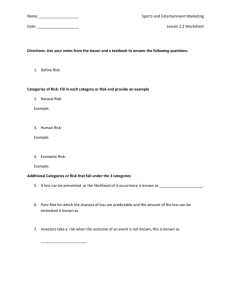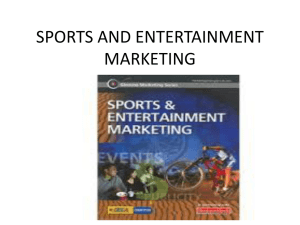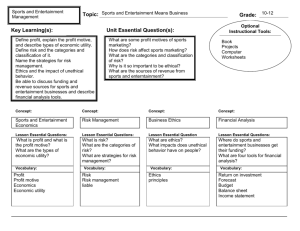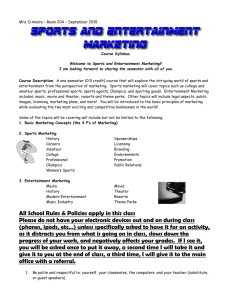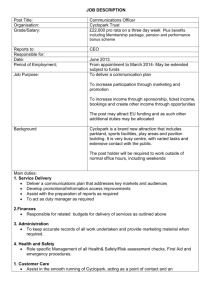File
advertisement
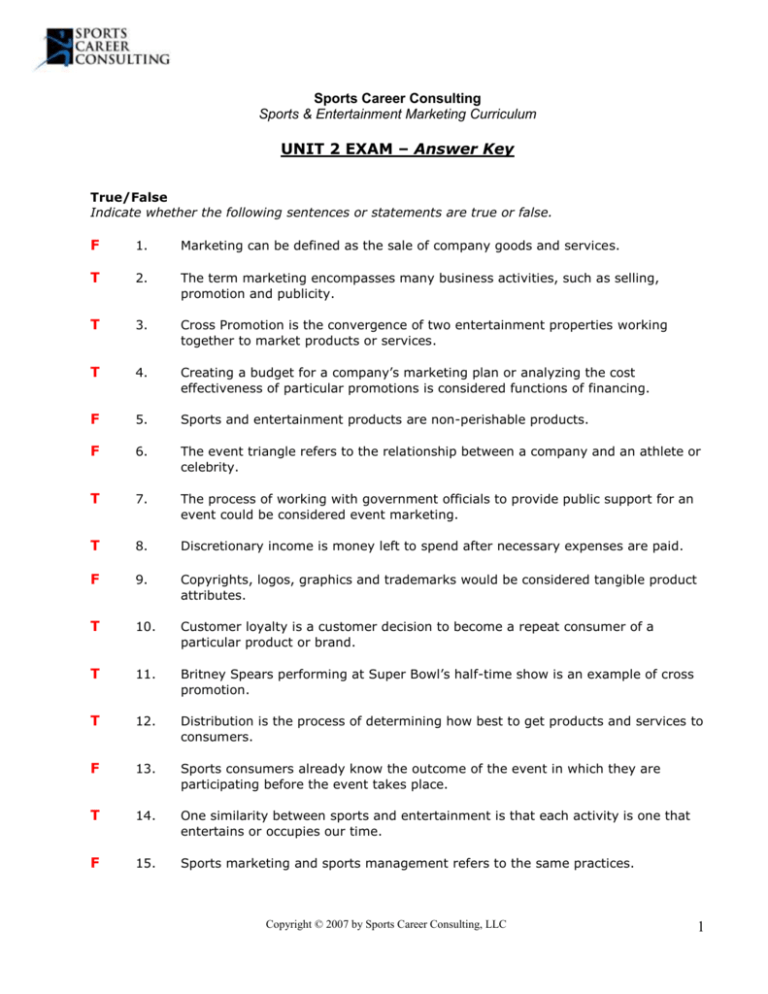
Sports Career Consulting Sports & Entertainment Marketing Curriculum UNIT 2 EXAM – Answer Key True/False Indicate whether the following sentences or statements are true or false. F 1. Marketing can be defined as the sale of company goods and services. T 2. The term marketing encompasses many business activities, such as selling, promotion and publicity. T 3. Cross Promotion is the convergence of two entertainment properties working together to market products or services. T 4. Creating a budget for a company’s marketing plan or analyzing the cost effectiveness of particular promotions is considered functions of financing. F 5. Sports and entertainment products are non-perishable products. F 6. The event triangle refers to the relationship between a company and an athlete or celebrity. T 7. The process of working with government officials to provide public support for an event could be considered event marketing. T 8. Discretionary income is money left to spend after necessary expenses are paid. F 9. Copyrights, logos, graphics and trademarks would be considered tangible product attributes. T 10. Customer loyalty is a customer decision to become a repeat consumer of a particular product or brand. T 11. Britney Spears performing at Super Bowl’s half-time show is an example of cross promotion. T 12. Distribution is the process of determining how best to get products and services to consumers. F 13. Sports consumers already know the outcome of the event in which they are participating before the event takes place. T 14. One similarity between sports and entertainment is that each activity is one that entertains or occupies our time. F 15. Sports marketing and sports management refers to the same practices. Copyright © 2007 by Sports Career Consulting, LLC 1 T 16. Entertainment marketing is the process of developing, promoting, and distributing products, or goods and services, to satisfy customer’s needs and wants through entertainment, or any diversion, amusement, or method of occupying time. T 17. Leisure time is the time available to people when they are not working or assuming responsibilities. T 18. Leisure time is often times referred to as “free time”. F 19. Coca-Cola’s sponsorship of the Olympics is an example of the marketing of sports. F 20. The NHL’s Carolina Hurricanes strategy to offer payment plans to ticket buying customers is an example of distribution. Multiple Choice Identify the letter of the choice that best completes the statement or answers the question. A. 1. _________ is defined as a source of diversion or physical activity engaged in for pleasure. a. Sports b. Entertainment c. Pro Wrestling d. Film producing D. 2. Which of the following is NOT a function of marketing? a. Pricing b. Distribution c. Promotion d. Tangible Product C. 3. Film, radio, television and music are all examples of ____: a. Sports b. Artistic Influence c. Entertainment d. Publicity B. 4. Sports and entertainment products are unique in that they are both ____: a. Expensive b. Perishable c. Unrealistic d. Fun D. 5. Which of the following are examples of event marketing? a. Marketing the event to athletes to secure their participation b. Marketing the event to corporations to urge sponsorship and general event support c. Creating a publicity strategy incorporating a plan to utilize the media to increase coverage of the event d. All of the above C. 6. Without sponsorships and corporate support, many events would ____ a. Sell out b. Not sell out c. Not be profitable d. Be profitable A. 7. Which of the following is not considered to be one of the 5 P’s of Event Marketing? a. Pricing b. Product c. Promotion d. Participation Copyright © 2007 by Sports Career Consulting, LLC 2 D. 8. Three key components of the event triangle include ____: a. Event, promotion, publicity b. Event, spectator, promotion c. Event, ticket sales, sponsor d. Event, sponsor, spectator A. 9. _________ is money left to spend after necessary expenses are paid. a. Discretionary Income b. Dispensable Income c. Disposable Income d. None of the above C. 10. Which a. b. c. d. B. 11. Watching a Broadway musical, listening to mp3s and playing tennis are all examples of ____. a. Marketing b. Entertainment c. Sports d. All of the above D. 12. The key differences between sports and entertainment involve ____: a. Being scripted b. Emotion c. Spontaneity d. All of the above B. 13. _________ can be defined as the process of gathering and using information about customers to improve business decision making. a. Selling b. Marketing Information-Management c. Product Management d. Pricing A. 14. Technology has advanced the role of entertainment marketing in many ways, including _____: a. Distribution channels b. Uniforms c. Parking d. Concessions D. 15. Which of the following organizations would be most likely to engage in strategic entertainment marketing? a. Six Flags Great America b. Pixar Animation Studios c. Disney World d. All of the above A. 16. The Chicago Bulls selling special “Holiday” ticket packages to fans is an example of ____: a. Marketing of sports b. Marketing through sports c. Entertainment Marketing d. Publicity A. 17. The role of corporate support in event marketing has __________________ in the past few decades. a. Increased b. Decreased c. Remained status quo d. Developed of the following would be considered an example of an intangible attribute? Copyright Football The “thrill” of winning a competition Napoleon Dynamite DVD Copyright © 2007 by Sports Career Consulting, LLC 3 D. 18. The Portland Trail Blazers advertising during film previews at a local cinema is an example of _____. a. Product Placement b. Entertainment Marketing c. Customer Loyalty d. Cross Promotion C. 19. _________ refers to the process of assigning a value to products and services on the basis of supply and demand. a. Marketing b. Financing c. Pricing d. Economics D. 20. Oreo cookies making an appearance on the sitcom Friends is an example of ___: a. Sponsorship b. Product Integration c. Product Placement d. B and C above Matching Match each item with the correct corresponding definition below. a. d. g. j. Marketing Leisure Time Call Center Sports Marketing b. e. h. Sports Industry Tangible Distribution B. 1. The market in which the businesses and products offered to its buyers are sport related and may be goods, services, people, places or ideas. E. 2. Goods and services that are capable of being physically touched. C. 3. Whatever people are willing to spend their money and spare time viewing rather than participating. G. 4. A physical location where calls are placed, or received, in high volume for the purpose of sales, marketing, customer service; typically through the use of telemarketers. H. 5. Determining how best to get products and services to consumers. D. 6. The time available to people when they are not working or assuming responsibilities, often times referred to as “free time”. J. 7. The act of using sports as a platform to market products or services and increase sales or the process of marketing and selling of the sports property itself. I. 8. The goods and services designed to provide benefits to a sports spectator, participant or sponsor. F. 9. Emphasizes the relationships between producers and consumers in the sports marketing model. A. 10. The process of developing, promoting, and distributing products, or goods and services, to satisfy customers’ needs and wants. Copyright © 2007 by Sports Career Consulting, LLC c. f. i. Entertainment Event Triangle Sports Product 4 Short Answer 1. List three examples of entertainment. Examples of entertainment could include Riding the “Superman: Ultimate Flight” ride at Six Flags Great America, attending a New York Yankees baseball game , reading Dan Brown’s best selling novel, The DaVinci Code, visiting the local zoo, going to a Kelly Clarkson or Jack Johnson concert, listening to the newest Outkast song on your mp3 player or watching the Broadway musical “Rent”. Please note that this question could result in a number of different answers. 2. List three examples of sports products/services. Examples of sports products/services could include licensed merchandise, sports participation, equipment and apparel, promotional items, sports facilities, marketing research and management services. Please note that this question could result in a number of different answers. 3. List and define three primary functions of marketing. The seven primary functions of marketing include: Pricing, distribution, promotion, financing, selling, marketing information-management and product/service management. 4. Explain what characteristics make sports and entertainment products unique. The characteristics that make sports and entertainment products unique are characteristics shared with services in that they can be perishable and intangible. 5. Clarify what is meant by the competition for entertainment dollars. Competition for the entertainment dollar is a reference to the many entertainment options available to the consumer today. The role of the sports and entertainment marketer is to find ways for consumers to spend those dollars with their organization. Essay Students should thoughtfully develop the key concepts listed in the answer key below. 1. Explain the difference between the marketing of sports and marketing through sports. Marketing through sports and entertainment occurs when companies use sports and entertainment as a vehicle to gain exposure for their products. The marketing of sports and entertainment is the marketing of the sports and entertainment products themselves. 2. Explain how technology has affected sports and entertainment marketing. Technology has advanced the role of entertainment marketing in many ways, including the advent of MP3 technology, online and on-demand video distribution, streaming audio and video capabilities. Ultimately, technology has impacted sports and entertainment marketing by making sports and entertainment products and services available for consumption via the Internet. Copyright © 2007 by Sports Career Consulting, LLC 5 3. Explain what differentiates sports from entertainment. The key differences between sports and entertainment include: 1) Sports are unscripted 2) Consumers have more emotional attachment to sports products/services 3) Sports consumers tend to have higher levels of customer loyalty Copyright © 2007 by Sports Career Consulting, LLC 6
